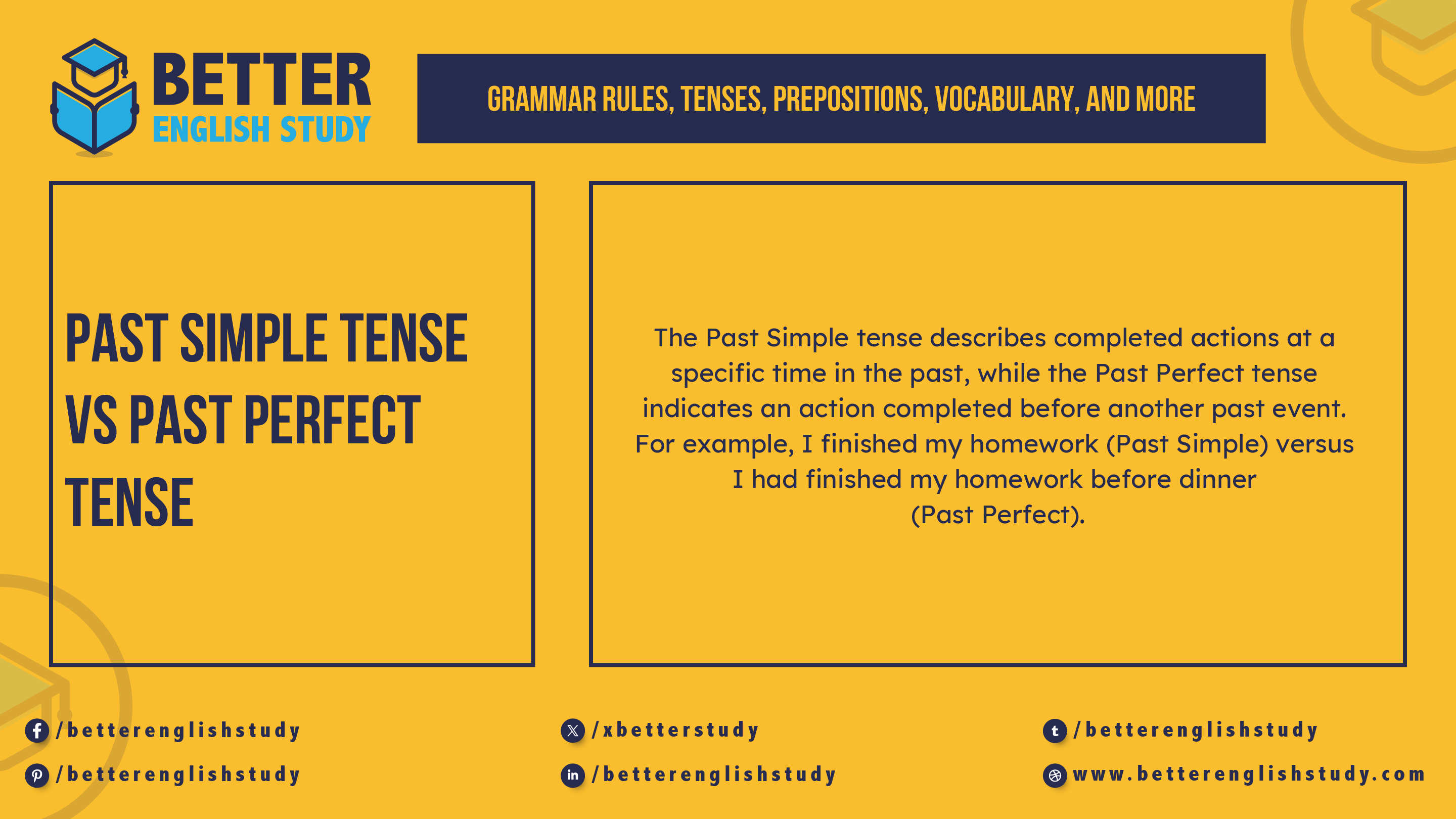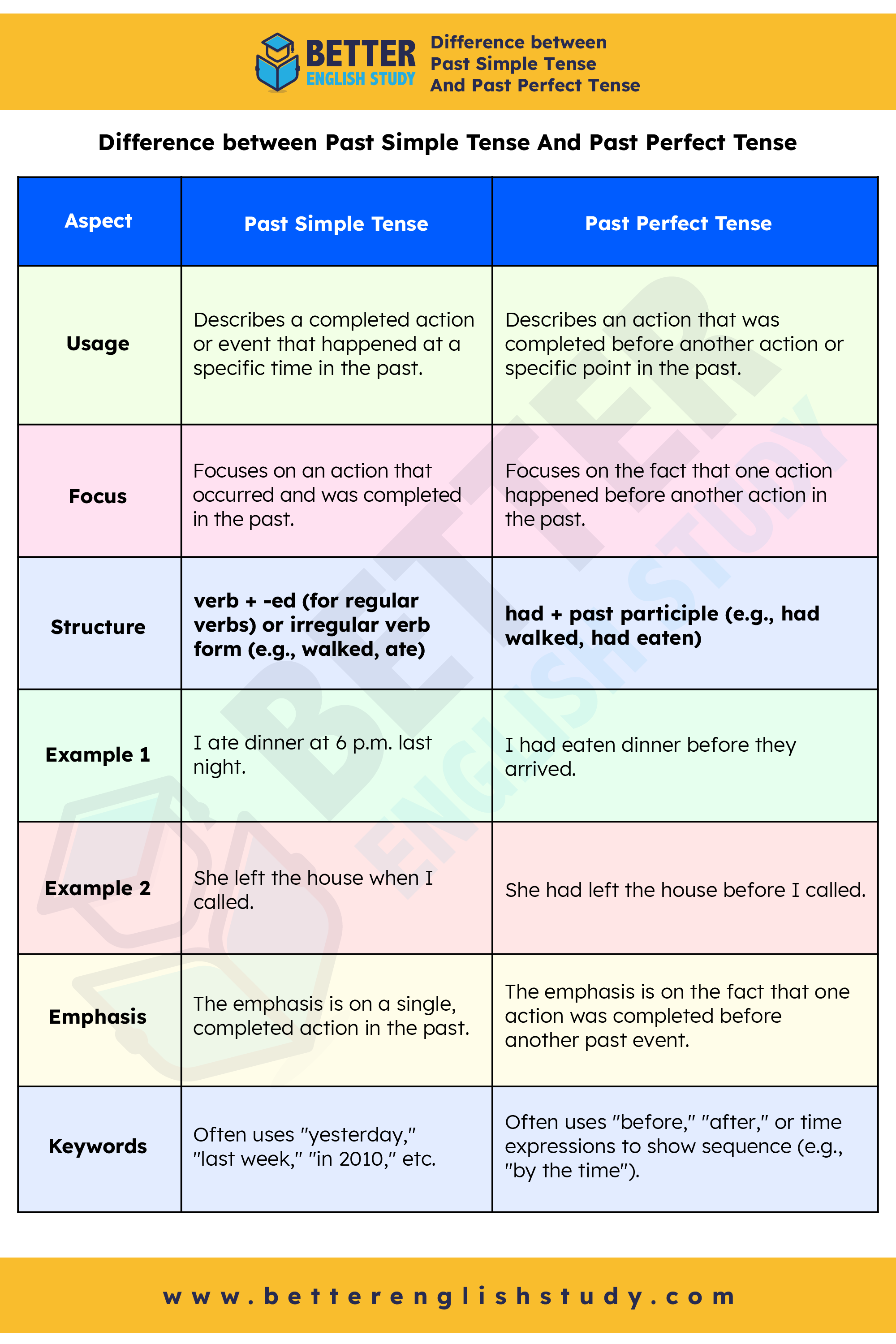
The Past Simple tense describes completed actions at a specific time in the past, while the Past Perfect tense indicates an action completed before another past event. For example, “I finished my homework” (Past Simple) versus “I had finished my homework before dinner” (Past Perfect).
Understanding tenses is essential for effective communication. English has various tenses to convey different times and aspects of actions. The Past Simple and Past Perfect tenses are often confused, yet they serve distinct purposes. Mastering these tenses can enhance your writing and speaking skills.
By recognizing the differences, you can express events more accurately, making your message clear. This clarity is vital for both casual conversations and formal writing.
Introduction To Past Tenses
Understanding tenses is key to mastering English. Past Simple describes actions that happened at a specific time. For example, “She played soccer yesterday.” This tense focuses on the action itself.
On the other hand, Past Perfect shows that one action happened before another. For instance, “She had played soccer before it started to rain.” This tense adds depth to the storytelling.
The role of time is crucial in the narrative. It helps clarify the sequence of events. Using the correct tense makes the story more engaging and easier to follow.
Using tenses correctly can change the meaning. Tense matters for clear communication. It helps listeners and readers understand the timing of events.
Basics Of Past Simple Tense
The Past Simple Tense is used to describe actions that happened in the past. It often involves a specific time. For example, “I visited my grandmother yesterday.”
To form the Past Simple Tense, use the past form of the verb. Regular verbs add -ed, like “play” becomes “played.” Irregular verbs change form, like “go” becomes “went.”
Common signal words include: yesterday, last week, in 2010, and two days ago. These words show the time of the action.
People often use this tense for completed actions. For example, “She finished her homework.” It tells us what happened and when.
Diving Deeper Into Past Perfect Tense
Past Perfect Tense shows actions completed before another past action. It uses “had” plus the past participle of the verb. For example, “I had eaten” means the eating happened before something else.
Key functions include showing the order of events. It helps clarify which action happened first. For instance, “She had finished her homework before she went out.” This clearly shows the homework was done first.
Indicators for using Past Perfect include phrases like “before,” “after,” and “by the time.” These words help to connect actions in the past.
In summary, mastering the Past Perfect Tense can improve clarity in storytelling.

Difference between Past Simple Tense And Past Perfect Tense
Here’s a table outlining the key differences between the past simple and past perfect tenses:
| Aspect | Past Simple Tense | Past Perfect Tense |
|---|---|---|
| Usage | Describes a completed action or event that happened at a specific time in the past. | Describes an action that was completed before another action or specific point in the past. |
| Focus | Focuses on an action that occurred and was completed in the past. | Focuses on the fact that one action happened before another action in the past. |
| Structure | verb + -ed (for regular verbs) or irregular verb form (e.g., walked, ate) | had + past participle (e.g., had walked, had eaten) |
| Example 1 | I ate dinner at 6 p.m. last night. | I had eaten dinner before they arrived. |
| Example 2 | She left the house when I called. | She had left the house before I called. |
| Emphasis | The emphasis is on a single, completed action in the past. | The emphasis is on the fact that one action was completed before another past event. |
| Keywords | Often uses “yesterday,” “last week,” “in 2010,” etc. | Often uses “before,” “after,” or time expressions to show sequence (e.g., “by the time”). |
- Past simple describes a completed action that occurred at a specific time in the past.
- Past perfect describes an action that was completed before another action or event in the past.
Examples To Clarify
Past Simple shows actions that happened at a specific time. For example, “She played soccer yesterday.” This tells us what happened and when.
Past Perfect indicates actions completed before another action. An example is, “He had finished his homework before dinner.” This shows the order of events clearly.
In Past Simple, the focus is on the action itself. In contrast, Past Perfect emphasizes the completion of an action before something else.
| Tense | Example |
|---|---|
| Past Simple | She visited her grandma last week. |
| Past Perfect | They had left before the rain started. |
Mistakes To Avoid
Many people confuse the Past Simple with the Past Perfect tense. The Past Simple describes actions that happened and finished in the past. For example, “I walked to the store.” This shows a completed action.
Common errors with Past Simple include using the wrong verb form. For instance, saying “I seen him yesterday” is incorrect. It should be “I saw him yesterday.”
Past Perfect indicates an action that happened before another action. An example is, “I had eaten before the game started.” This shows the order of events.
Frequent mistakes with Past Perfect include omitting “had.” Saying “I eaten before lunch” is wrong. It should be “I had eaten before lunch.”
Frequently Asked Questions
What Is The Past Simple Tense?
The Past Simple Tense describes actions completed in the past. It often uses regular verbs with “-ed” endings or irregular verbs in their unique forms. For example, “I walked to the store” and “She saw a movie. ” This tense emphasizes the fact that the action has finished.
How Is Past Perfect Tense Different?
Past Perfect Tense indicates an action completed before another action in the past. It uses “had” followed by the past participle of the verb. For instance, “I had finished my homework before dinner. ” This tense provides clarity on the sequence of past events.
Can You Give Examples Of Both Tenses?
Sure! In Past Simple, you might say, “He played soccer. ” In Past Perfect, an example is, “She had left before I arrived. ” These examples illustrate how each tense functions differently in expressing past actions and their timing.
When Should I Use Past Perfect?
Use Past Perfect when discussing two past actions. It clarifies which action occurred first. For example, “He had eaten before the guests arrived. ” This structure helps the reader understand the timeline of events clearly.
Conclusion
Understanding the difference between the past simple and past perfect tense is essential for clear communication. Each tense serves a unique purpose in storytelling and writing. By mastering these tenses, you can enhance your writing skills and convey your thoughts more effectively.
Practice using both tenses to become more confident in your grammar.
